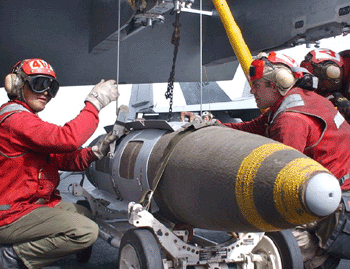
 Effective date: 7 August 2003
Effective date: 7 August 2003Description: The Joint Direct Attack Munition (JDAM) is a guidance kit that converts existing unguided bombs into precision-guided "smart" munitions. The tail section contains an inertial navigational system (INS) and a global positioning system (GPS). JDAM improves the accuracy of unguided bombs in any weather condition. It can be launched from every fighter or fighter-attack aircraft in the Navy's inventory.
Features: JDAM is a guided air-to-surface weapon using either the 2000lb BLU-109 hard-target-penetrator, the 2000-pound MK 84 or the 1,000-pound MK 83 warheads as the payload. JDAM allows fighters and bombers to deploy weapons accurately against targets on the ground. The JDAM uses a tail control system and a Global Positioning System (GPS)-aided Inertial Navigation System (INS) for guidance. Targeting information from the aircraft is transmitted electronically to the weapon.
Once released from the aircraft, the JDAM navigates to the target. Target coordinates can be loaded into the aircraft before takeoff, manually before weapon release, and automatically entered through target designation with onboard aircraft sensors. In its most accurate mode, when GPS data is available, the JDAM system will have an error of less than 13 meters.
JDAM enables multiple weapons to be directed against single or multiple targets on a single pass. It is launched from F/A-18 and F-14 aircraft.
Background: Operation Desert Storm revealed some shortcomings in air-to-surface weapon capability. Adverse weather conditions limited employment of precision guided munitions. Unguided weapon accuracy was also poor when the weapons were delivered from medium and high altitudes. Research and development of an "adverse weather precision guided munition" began in 1992. The first JDAMs were delivered in 1997 with operational testing conducted in 1998 and 1999. The more than 450 JDAMs dropped during testing had 95 percent system reliability and were accurate to within nine meters. JDAM also performed well in adverse weather testing, including clouds, rain and snow.
The Navy is currently studying the effects of adding enhancements such as improved GPS accuracy, a precision seeker for terminal guidance and additional warheads.
Point of Contact:
Public Affairs Office
Naval Air Systems Command
Washington, D.C. 20361-0701
General Characteristics:
Primary Function: Guided air-to-surface weapon
Contractor: Boeing Corporation
Unit Cost: Approximately $20,000
Length: (JDAM and warhead) GBU-31 (v) 2/B: 152.7 inches (387.9
centimeters); GBU-31 (v) 3/B: 148.6 inches (377.4 centimeters); GBU-32 (v) 2/B:
119.5 inches (303.5 centimeters)
Weight: (JDAM and warhead) GBU-31 (v) 2/B: 2,036 pounds (925.4
kilograms); GBU-31 (v) 3/B: 2,115 pounds (961.4 kilograms); GBU-32 (v) 2/B:
1,013 pounds (460.5 kilograms)
Wing Span: GBU-31: 25 inches (63.5 centimeters); GBU-32: 19.6
ins. (49.8 centimeters)
Range: Up to 15 miles (24 kilometers)
Ceiling: 45,000-plus feet (13,677 meters)
Guidance System: Global Positioning System (GPS)-aided Inertial Navigation System
(INS)
 Return to the Fact File Table of contents.
Return to the Fact File Table of contents.